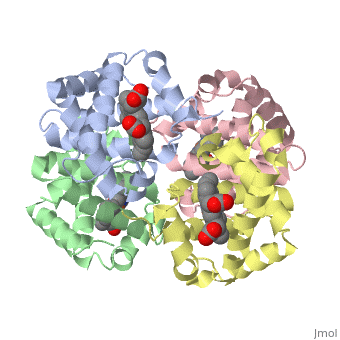Introduction to protein structure: Difference between revisions
Ann Taylor (talk | contribs) No edit summary |
Ann Taylor (talk | contribs) No edit summary |
||
| Line 1: | Line 1: | ||
== Levels of Protein Structure == | == Levels of Protein Structure == | ||
<StructureSection load='1A3N' size='350' side='right' caption='Structure of Hemoglobin (PDB entry [[1A3N]])' scene=''> | <StructureSection load='1A3N' size='350' side='right' caption='Structure of Hemoglobin (PDB entry [[1A3N]])' scene=''> | ||
Proteins are condensation polymers of amino acids. The <scene name='57/575866/Primary_sequence/1'>primary structure</scene> is the amino acid sequence. The <scene name='57/575866/Secondary_sequence/1'>secondary structure</scene> is the local structure over short distances. This level of structure is stabilized by <scene name='57/575866/H_bond_a_helix/1'>hydrogen bonds</scene> along the <scene name='57/575866/Backbone/1'>backbone</scene>. These secondary structures pack together to form the overall form of the entire peptide chain, called the <scene name='57/575866/Tertiary/1'>tertiary structure</scene>. Some proteins, such as the displayed hemoglobin molecule, have more than one polypeptide chain that associate to form the functional unit of the protein; this is called <scene name='57/575866/Tertiary/2'>quaternary structure</scene>. | Proteins are condensation polymers of amino acids. The <scene name='57/575866/Primary_sequence/1'>primary structure</scene> is the amino acid sequence. The <scene name='57/575866/Secondary_sequence/1'>secondary structure</scene> is the local structure over short distances. This level of structure is stabilized by <scene name='57/575866/H_bond_a_helix/1'>hydrogen bonds</scene> along the <scene name='57/575866/Backbone/1'>backbone</scene>. These secondary structures <scene name='57/575866/Global_secondary_structures/1'>pack together</scene> to form the overall form of the entire peptide chain, called the <scene name='57/575866/Tertiary/1'>tertiary structure</scene>. Some proteins, such as the displayed hemoglobin molecule, have more than one polypeptide chain that associate to form the functional unit of the protein; this is called <scene name='57/575866/Tertiary/2'>quaternary structure</scene>. | ||
'''Questions based upon these scenes:''' | '''Questions based upon these scenes:''' | ||
What is the primary sequence shown in the first link? | What is the primary sequence shown in the first link? | ||
| Line 7: | Line 7: | ||
The ith C=O of the backbone is hydrogen bonded to which N(-H) (use i +/- # to represent the number)? | The ith C=O of the backbone is hydrogen bonded to which N(-H) (use i +/- # to represent the number)? | ||
What atom does this program NOT show? | What atom does this program NOT show? | ||
What color is used to represent alpha helices? | |||
How many alpha helices are present in the single peptide chain shown? | |||
How many polypeptide chains make up the quaternary structure? | |||
== Ways of representing protein structure == | == Ways of representing protein structure == | ||
Revision as of 07:08, 16 January 2014
Levels of Protein StructureLevels of Protein Structure
Proteins are condensation polymers of amino acids. The is the amino acid sequence. The is the local structure over short distances. This level of structure is stabilized by along the . These secondary structures to form the overall form of the entire peptide chain, called the . Some proteins, such as the displayed hemoglobin molecule, have more than one polypeptide chain that associate to form the functional unit of the protein; this is called . Questions based upon these scenes: What is the primary sequence shown in the first link? Is the secondary structure shown an alpha helix or beta sheet? The ith C=O of the backbone is hydrogen bonded to which N(-H) (use i +/- # to represent the number)? What atom does this program NOT show? What color is used to represent alpha helices? How many alpha helices are present in the single peptide chain shown? How many polypeptide chains make up the quaternary structure? Ways of representing protein structureSecondary Structures |
| ||||||||||
